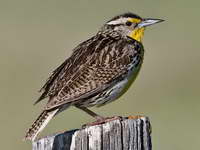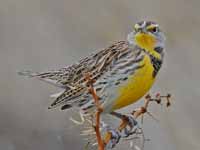BIRDS of THE WORLD - An Online Bird Book
ICTERIDAE
Meadowlarks
Order Passeriformes Family Icteridae
ICTERIDAE
The Icterids are a group of small to medium-sized, often colorful birds, restricted to the New World. Most species have black as a predominant plumage color, often enlivened by yellow, orange or red. The majority of icterid species live in the tropics, although there are a number of temperate forms. They inhabit a range of habitats, including scrub, swamp, forest, and savannah. Temperate species are migratory. Icterids are variable in size, and often display considerable sexual dimorphism. Their size varies 15-52 cm. One unusual adaptation shared is they can open their bills strongly rather than passively, allowing them to force open gaps to obtain otherwise hidden food. Some use their gaping motion to open the skins of fruit to obtain the soft insides, and have long bills adapted to the process. Others such as cowbirds have shorter stubbier bills for crushing seeds. Orioles will drink nectar. The nesting habits of these birds are similarly variable. [abstracted from Wikipedia]
Meadowlarks
Order Passeriformes Family Icteridae
Meadowlarks are belonging to genus Sturnella in the New World family Icteridae. This genus includes seven species of largely insectivorous grassland birds. In all species the male at least has a black or brown back and extensively red or yellow underparts. They closely resemble the Cape Longclaw of Africa, but they are not related.
Genus Sturnella
Meadowlark,_Eastern Sturnella magna Found: The Americas
The Eastern Meadowlark and the Western Meadowlark are very similar. Their ranges overlap, but those on the east coast of North America are Eastern Meadowlarks and those on the west are Western Meadowlarks. A minor difference is the width of the yellow on the chin. It is wider on the western.
Similar to: Dickcissel. Meadowlark long pointed bill; Dickcissel has short wedge shaped bill. Meadowlark larger.
Image by: 1, 2, 3, 4) Dick Daniels - Boquette, Panama
5) Richard Crook - Florida 6) Alastair Rae - Mexico 7) Mathew Paulson - Florida 8) Phil Johnson Similar to: Dickcissel. Meadowlark long pointed bill; Dickcissel has short wedge shaped bill. Meadowlark larger.
1) Adult and juvenile 2) Juvenile








Meadowlark,_Long-tailed Sturnella loyca Found: southern South America, Falkland Islands
The male Long-tailed Meadowlark has dark brown upperparts with blackish streaking; white supercilium; red lores, breast white spot near base of bill. Female is a dull version of the male.
Image by: 1, 2) Gustavo Duran - Argentina 3, 4) Dick Daniels - Chile



Meadowlark,_Pampas Sturnella defilippii Found: Argentina, Brazil, Uruguay
Image by: 1, 2, 3) Claudio Timm 4) Adrian Azpiroz




Meadowlark,_Peruvian Sturnella bellicosa Found: northernmost Chile, Ecuador, Peru
Themale Peruvian Meadowlark has streaky brown upperparts; bright red throat, breast. Females are duller and more streaked.
Image by: 1) Cepahs 2) Jerry Oldenettel -Ecuador 3) Carlo Castellani 4) Francesco_Veronesi - Ecuador2) Female 3, 4) Male




Meadowlark,_ Red-breastedalso Red-breasted Blackbird Sturnella militaris Found: South America
Image by: 1) Hector_Bottai 2, 3) Dominic Sherony 4) Tom Friedel (BirdPhotos.com) - Venezuela 5) Steve_Garvie - Trinidad
1, 2) Male 3) Female





Meadowlark,_Western Sturnella neglecta Found: North America
The Eastern Meadowlark and the Western Meadowlark are very similar. Their ranges overlap, but those on the east coast of North America are Eastern Meadowlarks and those on the west are Western Meadowlarks. A minor difference is the width of the yellow on the chin. It is wider on the western.
Image by: 1) JohnC Pics 2, 3) Alan D Wilson -
South Dakota 4) Jerry Oldenettel - New Mexico 5) David Mitchell 6) Becky_Matsubara





Meadowlark,_White-browed also White-browed Blackbird Sturnella superciliaris Found: South America
Image by: 1, 2, 3, 5) Claudio Timm - Brazil 4) Dario Sanches
1) Female 2, 3) Male nonbreeding 4, 5) Male breeding




